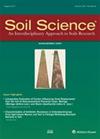Mapping land degradation risk due to land susceptibility to dust emission and water erosion
4区 农林科学
Q2 Agricultural and Biological Sciences
引用次数: 0
Abstract
Abstract. Land degradation is a cause of many social, economic, and environmental problems. Therefore identification and monitoring of high-risk areas for land degradation are necessary. Despite the importance of land degradation due to wind and water erosion in some areas of the world, the combined study of both types of erosion in the same area receives relatively little attention. The present study aims to create a land degradation map in terms of soil erosion caused by wind and water erosion of semi-dry land. We focus on the Lut watershed in Iran, encompassing the Lut Desert that is influenced by both monsoon rainfalls and dust storms. Dust sources are identified using MODIS satellite images with the help of four different indices to quantify uncertainty. The dust source maps are assessed with three machine learning algorithms encompassing the artificial neural network (ANN), random forest (RF), and flexible discriminant analysis (FDA) to map dust sources paired with soil erosion susceptibility due to water. We assess the accuracy of the maps from the machine learning results with the area under the curve (AUC) of the receiver operating characteristic (ROC) metric. The water and aeolian soil erosion maps are used to identify different classes of land degradation risks. The results show that 43 % of the watershed is prone to land degradation in terms of both aeolian and water erosion. Most regions (45 %) have a risk of water erosion and some regions (7 %) a risk of aeolian erosion. Only a small fraction (4 %) of the total area of the region had a low to very low susceptibility for land degradation. The results of this study underline the risk of land degradation for in an inhabited region in Iran. Future work should focus on land degradation associated with soil erosion from water and storms in larger regions to evaluate the risks also elsewhere.基于土地易受粉尘排放和水土流失影响的土地退化风险制图
摘要土地退化是许多社会、经济和环境问题的一个原因。因此,确定和监测土地退化高风险地区是必要的。尽管在世界上一些地区由于风蚀和水蚀导致的土地退化很重要,但在同一地区对两种侵蚀的综合研究相对较少受到关注。本研究旨在建立半干旱土地风蚀和水蚀引起的土壤侵蚀的土地退化图。我们关注的是伊朗的卢特流域,包括受季风降雨和沙尘暴影响的卢特沙漠。利用modis卫星图像识别尘源,借助四种不同的指数来量化不确定性。通过人工神经网络(ANN)、随机森林(RF)和灵活判别分析(FDA)等三种机器学习算法对尘源图进行评估,以绘制与水引起的土壤侵蚀敏感性配对的尘源图。我们用接受者工作特征(ROC)度量的曲线下面积(AUC)来评估机器学习结果的地图准确性。水和风成土壤侵蚀图用于识别不同类型的土地退化风险。结果表明,43%的流域在风蚀和水蚀方面都容易发生土地退化。大多数地区(45%)存在水蚀风险,一些地区(7%)存在风蚀风险。该地区只有一小部分(4%)的土地退化易感性为低至极低。这项研究的结果强调了伊朗无人居住地区土地退化的风险。未来的工作应该集中在更大地区与水和风暴造成的土壤侵蚀有关的土地退化,以评估其他地方的风险。
本文章由计算机程序翻译,如有差异,请以英文原文为准。
求助全文
约1分钟内获得全文
求助全文
来源期刊

Soil Science
农林科学-土壤科学
CiteScore
2.70
自引率
0.00%
发文量
0
审稿时长
4.4 months
期刊介绍:
Cessation.Soil Science satisfies the professional needs of all scientists and laboratory personnel involved in soil and plant research by publishing primary research reports and critical reviews of basic and applied soil science, especially as it relates to soil and plant studies and general environmental soil science.
Each month, Soil Science presents authoritative research articles from an impressive array of discipline: soil chemistry and biochemistry, physics, fertility and nutrition, soil genesis and morphology, soil microbiology and mineralogy. Of immediate relevance to soil scientists-both industrial and academic-this unique publication also has long-range value for agronomists and environmental scientists.
 求助内容:
求助内容: 应助结果提醒方式:
应助结果提醒方式:


